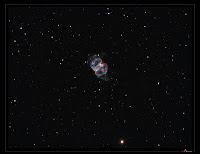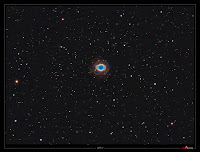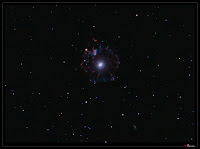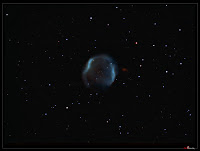COPYRIGHT, PLEASE NOTE
All the material on this website is copyrighted to J-P Metsavainio, if not otherwise stated. Any content on this website may not be reproduced without the author’s permission.
BUY A MUSEUM QUALITY POSTER
BUY A POSTER:https://astroanarchy.zenfolio.com/
Tuesday, February 15, 2011
Caldwell 49, the "Rosette Nebula"
"Rosette Nebula"
Ra 06h 33m 45s Dec +04° 59′ 54″
Image is in HST-palette, (HST=Hubble Space Telescope)
from the emission of ionized elements, R=Sulfur, G=Hydrogen and B=Oxygen.
Star colors are mixed from the NB channels, Red=H-a, G=O-III and B= 85%O-III + 15%H-a.
This image is from two nights, 09.02 and 13.02. It was very cold, about -25C, at both nights.
I had an orthogonality problem with QHY9 and the Tokina AT-X 300mm f2.8 lens. The problem is now fixed and the optical axle and the CCD are now perfectly perpendicular to each others.
The Rosette Nebula (also known as Caldwell 49) is a large, circular H II region located near one end of a giant molecular cloud in the Monoceros. The open cluster NGC 2244(Caldwell 50) is closely associated with the nebulosity, the stars of the cluster having been formed from the nebula's matter. The cluster and nebula locates at a distance of about 5,200 light years from Earth. The diameter is about 130 light years.
The radiation from the young stars ionized the atoms in the nebula, causing them to emit light, typical to each element, producing the visible nebula. Stellar winds, radiation pressure, from a group of stars cause compression to the interstellar clouds, followed by star formation in the nebula. This star formation is currently still ongoing.
Natural color composition from the emission of ionized elements, R=80%Hydrogen+20%Sulfur, G=100%Oxygen and B=85%Oxygen+15%Hydrogen to compensate otherwise missing H-beta emission. This composition is very close to a visual spectrum.
The scale
In this image, there is a full Moon placed as a scale.
The diameter of the full Moon is about 30', 0.5 degrees.
Image area is about 193', 3,2 degrees, wide.
The scale
In this image, there is a full Moon placed as a scale.
The diameter of the full Moon is about 30', 0.5 degrees.
Image area is about 193', 3,2 degrees, wide.
An older, wider view, mosaic image of the Rosette area.
Colors for the new image are taken from this older capture.
Technical information in original blog post:
Processing work flow:
Image acquisition, MaxiDL v5.07.
Stacked and calibrated in CCDStack.
Deconvolution with a CCDSharp, 20 iteration, added at 50% weight.
Levels, curves and color combine in PS CS3.
Equipments:
Tokina AT-a 300mm f2.8 @ f2.8
Platform and guiding, Meade LX200 GPS 12" @ f5
Camera, QHY9
Guider, Lodestar
Image Scale, 3,83 arcseconds/pixel
Exposures:
Baader H-alpha 7nm 15x1200s, binned 1x1 (5h)
Other channels are from an older image:
A closeup of the Rosette Nebula from Spring season 2010
Original blog post with a technical details:
Thursday, February 10, 2011
IC 1848, the "Soul Nebula"
IC 1848, the "Soul Nebula"
Ra 02h 51m 36.24s Dec +60° 26′ 53.9"
from the emission of ionized elements, R=Sulfur, G=Hydrogen and B=Oxygen.
Star colors are mixed from the NB channels, Red=H-a, G=O-III and B= 85%O-III + 15%H-a.
It was clear last night for a while. I have shot lots of longer focal length images at last couple of winters.
This time I used a Tokina AT-x 300mm camera lens at full aperture, f2.8, coupled with a QHY9 astronomical camera. This lens delivers image with a spatial resolution of 3,83 arc seconds/pixel and the field of field is
213' x 159' (3,55 x 2,65 degrees). There is now a QHY filter wheel attached, focusing is done by the FocuMax software and a DIY focusing mechanism for camera lenses. Image of it can be seen here:
I had lots of problem with this image. First of all, the CCD was not perfectly perpendicular to an optical axle,
I'll fix that tonight. Secondly my old Meade has some looseness in Ra mechanism, I think it's simply worn out, guiding was very jumpy due that.
Soul Nebula, (Sh2-199, LBN 667) is an emission nebula in constellation Cassiopeia. IC 1848 is a cluster inside Soul Nebula. Distance is about 7.500 light years. This complex is a Eastern neighbor of IC 1805, the "Heart Nebula" and they are often mentioned together as Heart and Soul.
Here is an older image, showing both objects:
Colors for this new image are taken from this older image.
Processing work flow:
Image acquisition, MaxiDL v5.07.
Stacked and calibrated in CCDStack.
Deconvolution with a CCDSharp, 20 iteration, added at 50% weight.
Levels, curves and color combine in PS CS3.
Equipments:
Tokina AT-a 300mm f2.8 @ f2.8
Platform and guiding, Meade LX200 GPS 12" @ f5
Camera, QHY9
Guider, Lodestar
Image Scale, 3,83 arcseconds/pixel
Exposures:
Baader H-alpha 7nm 11x1200s, binned 1x1
Other channels are from older image:
An image showing the size of this object compared to a full Moon.
(Full moon has a diameter of 30', that's 0,5 degrees)
Two older closeup images of the Soul Nebula.
Monday, February 7, 2011
A Supernova Remnant poster
A collection of Supernova remnants in scale
Note! There is now an image of a full Moon as a scale.
I made this poster to show relative sizes of the Supernova remnants. All SNR's in this poster are in same scale.
A full size image, or if an image is smaller, an image holder( dark gray), covers 259' horizontally (4,3 degrees)
NOTE, there are zoomed versions from M1 and IC 443, they are not in scale, the smaller versions of them are in scale with rest of the images.
Images are in HST-palette, mixed from the emission of ionized elements, Sulfur, Hydrogen Oxygen, by a a following method:
Red = S-II, Green = H-alpha and Blue = O-III
A supernova remnant (SNR) is the structure resulting from the gigantic explosion of a star.
The supernova remnant is an expanding shock wave and consists of ejected material expanding from the explosion.
There are two possible routes to a supernova:
There are two possible routes to a supernova:
1. A massive star may run out of fuel and collapsing inward under the force of its own gravity to form a neutron star or a black hole.
2. A white dwarf star accumulate material from a companion star until it reaches a critical mass and undergoes a thermonuclear explosion.
Images, from top Left to a bottom Right
Click thumbnails for large images, technical data behind links
Simeis 147 aka Sh2-240:
http://astroanarchy.blogspot.com/2011/01/reprocessed-supernova-remnants.html (scroll down a bit)
Veil Nebula;
M1, the "Crab Nebula":
IC 443, the "Jellyfish Nebula":
Friday, February 4, 2011
A Planetary Nebula poster
Note! There is now a Gray circle, size of the full Moon, as a scale.
I made this poster to show and understand relative sizes of the nebulae. All Planetary Nebulae in this image are in same scale. Each individual image covers an area of 20' horizontally. (~0,3 degrees) and
they are in "natural" colors, mixed from the narrowband channels. By a following method:
Natural color composition from the emission of ionized elements, R=80%Hydrogen+20%Sulfur, G=100%Oxygen and B=85%Oxygen+15%Hydrogen to compensate otherwise missing H-beta emission. This composition is very close to a visual spectrum.
I have made a similar poster out of supernova remnants as well, you can see it from here:http://astroanarchy.blogspot.com/2011/02/supernova-remnant-poster.html
I have made a similar poster out of supernova remnants as well, you can see it from here:http://astroanarchy.blogspot.com/2011/02/supernova-remnant-poster.html
All images, expect NGC 6302 (Bug Nebula), are shot from my urban observatory in very centrum of city Oulu. NGC 6302 was shot with a remote telescope, 16" RCOS, from Australia.
All of the images are Planetary Nebulae.
Planetary nebulae are shells of gas, shed by stars late in their life cycles after using up all of their nuclear fuel. The gas is illuminated and ionized by its extremely hot central star, a core left from the original star.
Our own star, the Sun, is expected to undergo the same process in a couple of billion years.
Images, from top Left to a bottom Right
Click thumbnails for large images, technical data behind links
Click thumbnails for large images, technical data behind links
M27, the "Dumbbell Nebula":
M76, the "Little Dumbbell Nebula":
http://astroanarchy.blogspot.com/2010/11/m-76-little-dumbbell-nebula.html

PK 164+31.1, Jones-Emberson 1:

PK 164+31.1, Jones-Emberson 1:
M57, the "Ring Nebula":
http://astroanarchy.blogspot.com/2010/10/m57-ring-nebula-project-finalized.html

Sh2-188:
http://astroanarchy.blogspot.com/2010/11/sh2-188-project-finalized.html
NGC 6543, the "Cat's Eye Nebula":
http://astroanarchy.blogspot.com/2010/10/m57-ring-nebula-project-finalized.html

Sh2-188:
http://astroanarchy.blogspot.com/2010/11/sh2-188-project-finalized.html
NGC 6543, the "Cat's Eye Nebula":
http://astroanarchy.blogspot.com/2011/01/cats-eye-nebula-reprocessed.html

Sh2-274, the "Medusa Nebula":
http://astroanarchy.blogspot.com/2011/02/medusa-nebula-sh2-271-project-finalized.html
Jones 1:
http://astroanarchy.blogspot.com/2010/11/jones-1-extreme-dim-planetary-nebula.html

NGC 6302, the "Bug Nebula":

Sh2-274, the "Medusa Nebula":
http://astroanarchy.blogspot.com/2011/02/medusa-nebula-sh2-271-project-finalized.html
Jones 1:
http://astroanarchy.blogspot.com/2010/11/jones-1-extreme-dim-planetary-nebula.html

NGC 6302, the "Bug Nebula":
Thursday, February 3, 2011
M27, the "Dumbbell Nebula", as a Stereo Pair 3D
3D-experiment with the M27
Parallel vision 3D
NOTE! This is a personal vision about forms and shapes, based on some known facts and an artistic impression.
Labels:
stereo images
M27, the "Dumbbell Nebula", as an anaglyph Red/Cyan 3D
You'll need Red/Cyan Eyeglasses to be able to see this image right.
Note, if you have a Red and Blue filters, you can use them! Red goes to Left eye.
A closeup
NOTE! This is a personal vision about forms and shapes, based on some known facts and an artistic impression.
Labels:
anaglyph images and movies
Wednesday, February 2, 2011
M27, the "Dumbbell Nebula", reprocessed
Since my processing technique gets better and weather doesn't give any support, I have reprocessed some older images. There is now star colors added and other processing is tweaked too.
Messier 27, the "Dumbbell Nebula"
Ra 19h 59m 36.340s Dec +22° 43′ 16.09″
Be sure to click to an image to see it in large size!
Natural color composition from the emission of ionized elements, R=80%Hydrogen+20%Sulfur, G=100%Oxygen and B=85%Oxygen+15%Hydrogen to compensate otherwise missing H-beta emission. This composition is very close to a visual spectrum.
Natural color composition from the emission of ionized elements, R=80%Hydrogen+20%Sulfur, G=100%Oxygen and B=85%Oxygen+15%Hydrogen to compensate otherwise missing H-beta emission. This composition is very close to a visual spectrum.
The Dumbbell Nebula (also known as a Messier 27, M 27, or NGC 6853) is a planetary nebula in the constellation Vulpecula, at a distance of about 1360 light years. It has a large angular diameter as a planetary nebula, about 8 x 5,6 arc minutes. (Rarely imaged outer halo is not included, it can be seen in my image. With an outer shell, the diameter is over 15'' (more than a size of the half a Moon))
Planetary nebulae are shells of gas shed by stars late in their life cycles after using up all of their nuclear fuel. The star then ejects a gaseous shell, which is illuminated by its extremely hot central star, a core left from the original star. n this image, the central star is clearly visible at very center of the nebula. M27's central star has a magnitude of 13.5 and is an extremely hot blueish dwarf with a temperature of about 85,000 K.
Our own star, the Sun, is expected to undergo the same process in a couple of billion years.
Be sure to click to an image to see it in large size!
Image is in HST-palette, (HST=Hubble Space Telescope)
Image is in HST-palette, (HST=Hubble Space Telescope)
from the emission of ionized elements, R=Sulfur, G=Hydrogen and B=Oxygen.
Star colors are mixed from the NB channels, Red=H-a, G=O-III and B= 85%O-III + 15%H-a.
A closeup
no other processing, than calibration, stacking and nonlinear stretching.
In the final image, light deconvolution with a CCDSharp software was added, 30 iterations.
(Value 3 in CCDSharp)
Image is shot with a QHY9, Baader narrowband filter set and the Meade lx200 GPS 12" telescope..
Original versions from November 2009, with technical details:
Sh2-274, the "Medusa Nebula" as a Stereo Pair 3D
Parallel vision 3D
Cross vision 3D
Other 3D-formats:
Original 2D:
NOTE! This is a personal vision about forms and shapes, based on some known facts and an artistic impression.
Labels:
stereo images
Sh2-274, the "Medusa Nebula" as an anaglyph Red/Cyan 3D
You'll need Red/Cyan Eyeglasses to be able to see this image right.
Note, if you have a Red and Blue filters, you can use them! Red goes to Left eye.
Other 3D-formats:
Original 2D:
NOTE! This is a personal vision about forms and shapes, based on some known facts and an artistic impression.
Labels:
anaglyph images and movies
Tuesday, February 1, 2011
The "Medusa Nebula", Sh2-274, project finalized
Sh2-274, the "Medusa"
from the emission of ionized elements, R=Sulfur, G=Hydrogen and B=Oxygen.
Star colors are mixed from the NB channels, Red=H-a, G=O-III and B= 85%O-III + 15%H-a.
The Medusa Nebula is a large planetary nebula in the constellation of Gemini on the border of the Canis Minor. It also known as Abell 21 and Sharpless 274 (Sh2-274)
This nebula was thought to be a supernova remnant until early 1970, now it's known to be a planetary nebula.
Distance is about 1500 light years.
This has been the most difficult target to me to shoot by so far. The surface brightness of this, very diffused planetary, is reported to be between magnitude +15,99 up to +25!
Up here, at 65N, this target doesn't get very high and usually this time of the year is very cloudy. I started this project back in March 2010.
Processing work flow:
Image acquisition, MaxiDL v5.07.
Stacked and calibrated in CCDStack.
Levels, curves and color combine in PS CS3.
Equipments:
Telescope, Meade LX200 GPS 12" @ f5
Camera, QHY9 Guiding, SXV-AO @ 4,5Hz
Image Scale, 0,75 arcseconds/pixel
Exposures:
Baader H-alpha 7nm 5x1200s, binned 2x2
Baader H-alpha 7nm 5x1200s, binned 2x2 from previous session at January 12. 2011
Baader H-alpha 7nm 7x1200s, binned 1x1 from previous session at March 14.2010.
Baader O-III 8,5nm 3x1200s, binned 3x3
Baader O-III 8,5nm 1x1200s, binned 4x4 from previous session at January 12. 2011
Baader S-II 8nm 3x1200s, binned 4x4
EDIT.
There was some reflections in a O-III channel (Blue). I have fixed the channel now.
Special thanks to a "Bill W" from a "Cloudynights forum" to point this out.
EDIT.
There was some reflections in a O-III channel (Blue). I have fixed the channel now.
Special thanks to a "Bill W" from a "Cloudynights forum" to point this out.
Sh2-142, the "Wizard Nebula", wide field & a closeup reprocessed
Since my processing technique gets better and weather doesn't give any support, I have reprocessed some older images. There is now star colors added and other processing is tweaked too.
Sh2-142, the "Wizard"
Ra 22h 47.0m Dec 58° 06′
Image is in HST-palette, (HST=Hubble Space Telescope)
from the emission of ionized elements, R=Sulfur, G=Hydrogen and B=Oxygen.
Star colors are mixed from the NB channels, Red=H-a, G=O-III and B= 85%O-III + 15%H-a.
NGC 7380 is an open cluster inside the nebula. The "Wizard Nebula" is also known as a Sharpless catalog number 142. (Sh2-142) The nebula is relatively large object located in constellation Cepheus about 7000 light years away.
Natural color composition from the emission of ionized elements, R=80%Hydrogen+20%Sulfur, G=100%Oxygen and B=85%Oxygen+15%Hydrogen to compensate otherwise missing H-beta emission. This composition is very close to a visual spectrum.
Image is shot with a QHY8 and the Tokina AT 300mm f2.8 lens at full aperture.
Original versions from November 2008, with technical details:
Sh2-142, the "Wizard" a closeup
Image is in HST-palette, (HST=Hubble Space Telescope)
from the emission of ionized elements, R=Sulfur, G=Hydrogen and B=Oxygen.
Star colors are mixed from the NB channels, Red=H-a, G=O-III and B= 85%O-III + 15%H-a.
This is a newer closeup image of the actual nebula. It covers about 30 arc minutes horizontally.
Original processing from September 2010 and technical details can be found here:
Subscribe to:
Comments (Atom)












































